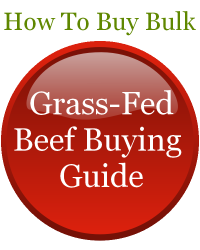Grass Fed Beef Buyers — Beware
With the increasing popularity of "grass fed" beef due to its great health benefits, there are an increasing number of imposters in the business that want to be the lowest price supplier. Here are some things you need to know before you buy.
- What does "Finished" mean? This means that the animal is physiologically mature; no longer growing in stature and frame; and is on a diet that will allow the animal to build fat reserves. Where this fat is deposited in or on the animal depends partly on breed of animal and partly on feed quality. A prime or choice grade animal will deposit fat within the muscle tissue. This is called marbling and is a good indicator of flavor and tenderness of the meat – particularly the steaks. A "grass fed" animal younger than 24 months or lighter than 1000 pounds live weight is very likely NOT finished.
- "Grass fed" vs. "Grass Finished" – Almost all cattle are grass fed for some period of their lives, especially the beef breeds where the calf runs with the mother cow for a few months after birth. Because of this fact, many will claim that their beef has been "grass fed". A typical beef animal is weaned from its mother, taken off the grass, put into a feedlot and fed corn or other high starch diet. This high starch diet causes very rapid growth and then high fat deposits as the animal matures. This type of fat is high in Omega 6 fatty acid or "bad cholesterol". Now, a true "grass FINISHED" animal continues on a grass (forage) diet with no grain at all. Because there is little starch in the grass diet, the growth of the animal is slower and the fat deposited is high in Omega 3 fatty acid (the good cholesterol). Because of the slower growth, the farmer has more time and expense in producing real "grass finished" animals. Thus the necessity for a higher price.
- Price – Now this is where it gets interesting! Ask these questions: Is the price based on live weight, hanging weight, or weight of the finished meat you put in your freezer? Who pays the butchering charger? Is delivery included? You had better ask these questions and use your calculator or you may be in for a rude awakening when you go to the meat shop to get your beef. In a general example, a 1000 pound animal live weight will be about 550 pounds hanging weight(this means the skin is off and the guts are out), which will be about 320 pounds of actual de-boned, trimmed, meat that you are going to put in your freezer. The butchering charges will be 40-65 cents per pound based on hanging weight.
Now as an educated consumer you will know how to read an ad that says "Grass fed beef right off our pasture-ready for butchering-weighs about 450 pounds. Only $400" I assure you that you will get what your pay for – a young calf, with no fat, very little flavor, and a high price tag by the time he is in your freezer.
For superior flavor and quality, choose Brady's Beef. Thanks for your support of locally grown, healthy food.
How do I order a 1/2 beef?
Make a $100 deposit below or contact John:
- Email: John@BradysBeef.com
- Phone: (208) 251-5206
We make regular deliveries along the I-15 corrider from Idaho Falls, ID to Provo, UT. If outside that area, call or email to discuss delivery options.

